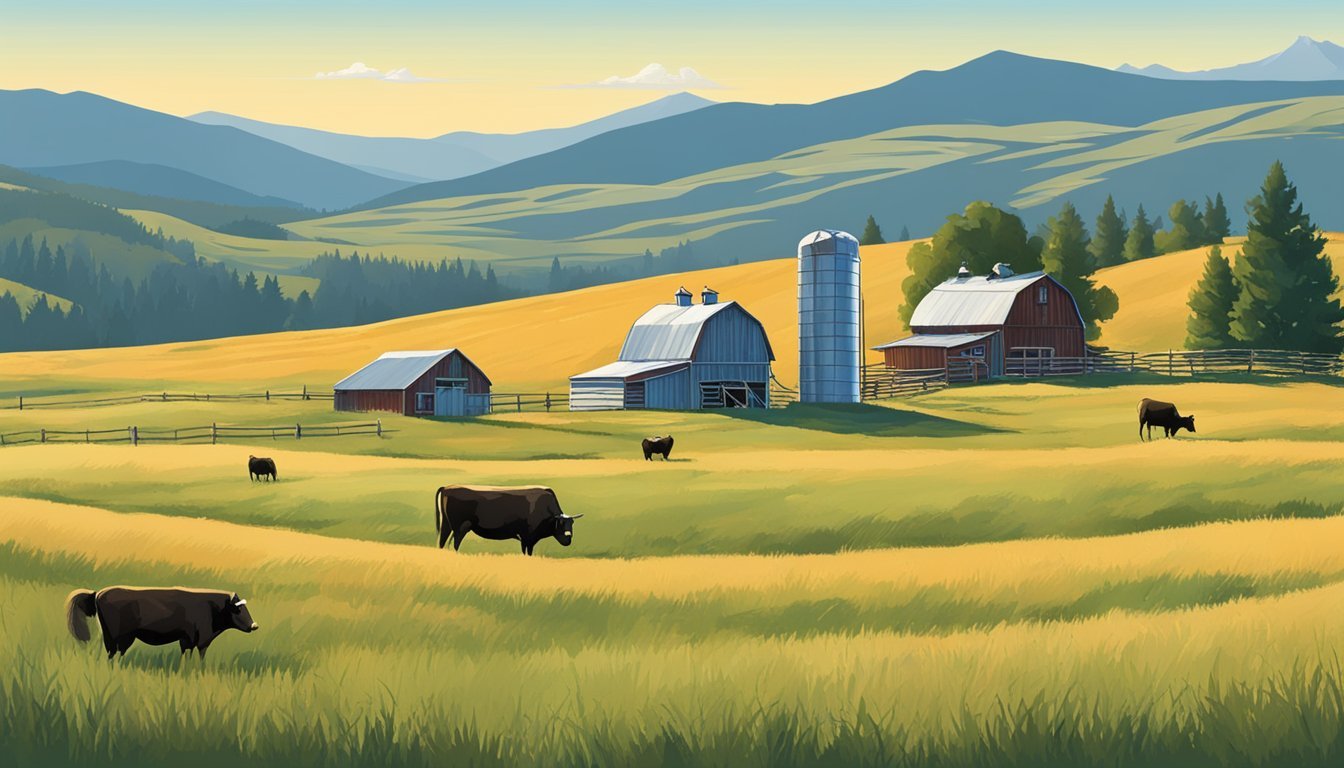Montana Farm Land for Lease
Opportunities for Growth and Investment
This Article is Part of Our Guide on Navigating Agricultural Leases Across the US
Montana farm land for lease embodies a unique opportunity for those looking to engage in agriculture or diversify their investment portfolio in the Treasure State. With its expansive skies and fertile soils, Montana offers a range of properties suitable for farming and ranching. While outright land ownership may be a significant investment, leasing agricultural land is a cost-effective alternative that grants access to the land’s productive capacity without the upfront costs associated with purchasing.
Leasing farm land in Montana has become increasingly popular as it provides a way for farmers, both seasoned and new entrants, to cultivate crops or manage livestock on established agricultural grounds. Trusts and organizations like Trust Montana have partnered with entities such as the Agrarian Trust to create systems that support the leasing of farmland to responsible stewards. This collaborative approach ensures that the land continues to be managed sustainably, offering long-term leases to those committed to agriculture.
Prospective lessees can explore a variety of land options, from smaller plots ideal for boutique farming to extensive acreages capable of supporting larger scale operations. The leasing terms and conditions are subject to negotiation and collaboration between landholders and farmers, aiming for agreements that benefit all parties involved. With careful observation of legal requirements and market conditions, entities and individuals can find leasing opportunities that align with both their agricultural endeavors and financial constraints.
Understanding Farm Land Leasing
When entering the farm land leasing market in Montana, potential lessees and lessors must be aware of lease types, how to determine lease terms, and the process of evaluating land for farming purposes.
Types of Leases
There are primarily two types of agricultural leases common in Montana: cash rent leases and share leases. In a cash rent lease, the tenant pays a set amount of rent either per acre or in total, irrespective of the farm's production outcomes. Conversely, share leases involve both the landowner and the tenant sharing the costs and revenues according to predetermined percentages.
Determining Lease Terms
Lease terms involve several important factors:
Duration: A lease in Montana typically spans from year-to-year unless otherwise agreed upon.
Payment Structure: This could be a fixed amount per acre, a percentage of the revenue, or a combination.
Responsibilities: It’s crucial to specify which party is responsible for activities such as maintenance, improvements, and insurance.
Careful negotiation is important to ensure both parties understand their commitments under a lease agreement.
Land Evaluation for Farming
When assessing land for lease, several considerations are key to evaluate its suitability for farming:
Soil Quality: The fertility and type of soil determine what can be grown.
Water Resources: Availability of water sources for irrigation is critical.
Accessibility and Infrastructure: This includes roads, storage facilities, and proximity to markets.
Landowners and farmers must both ensure the land is apt for the intended agricultural use to forge a successful leasing relationship.
Montana's Agrarian Landscape
Montana's vast and fertile lands are an integral part of the state's identity, with farming and ranching practices that have evolved over generations. This region's agricultural framework is characterized by traditional family-owned farms as well as progressive alliances, such as the Montana Agrarian Commons, which seek to support and sustain local farming communities.
Farming in Montana
Montana is renowned for its extensive agricultural lands, where farming is a way of life and an important economic driver. With a range of climates and soils, the state yields a variety of crops and livestock. Montana's farms and ranches spread across millions of acres, a testament to the state's role as a leading agricultural player. Here, the prominence of wheat and barley (how long does barley last?) stands alongside cattle ranching as cornerstones of the state's agricultural output.
Key Agricultural Facts:
Land in Farms: Montana has over 58 million acres of farmland.
Primary Crops: Wheat, barley, and pulse crops like lentils (how long do lentils last?) and chickpeas.
Livestock: Cattle ranching is significant in the state's eastern plains.
Montana Agrarian Commons
The Montana Agrarian Commons is a novel initiative that underlines the community-driven approach to land stewardship in Montana. Formed through a partnership in 2020, this entity is a 501(c)25 non-profit that acquires and holds farmland to lease it long-term to farmers. This arrangement ensures that the farmland is used sustainably and remains accessible to local farmers.
Agrarian Commons Objectives:
Land Stewardship: Promoting sustainable farming practices.
Farmer Support: Providing access to land for new and established farmers.
Community Involvement: Fostering connections between the land, farmers, and the wider community.
These efforts reflect a commitment to preserving the Montana farming tradition and supporting a new generation of farmers who are the backbone of the state's agrarian landscape.
Legal and Economic Considerations
Leasing farm land in Montana requires careful consideration of state-specific legal requirements and the economic implications of such agreements. Landowners and lessees must navigate regulations and licenses while assessing the financial viability of land leasing arrangements.
State Regulations and License
Montana's legal framework establishes guidelines for agricultural land leases, making compliance with state regulations and obtaining the proper licenses imperative. The Montana Department of Agriculture mandates that lessees involved in commercial farming activities hold appropriate licenses. Moreover, it's crucial for parties to ensure that lease agreements adhere to state law, which may dictate terms of use, tenure security, and other contractual obligations.
Essential legal documents:
Written lease agreement
Disclosure of any environmental conditions affecting the land
Compliance certificates for licenses held
Key contacts:
Montana State University (MSU) Extension Economics
Local county Extension agents
Agricultural legal experts in Montana
Economics of Land Leasing
Economic considerations of land leasing involve understanding lease rate statistics and employing tools for lease calculation. Specialists such as Keri Hayes, from the MSU Extension Economics, along with experts like George Haynes and Joel Schumacher, provide valuable insights and resources to Montana landowners and lessees aiming to establish fair and profitable lease arrangements.
Financial aspects to consider:
Lease rate statistics
Calculation tools
Potential revenue streams from leased land
Soil quality and water availability for maximizing land productivity
Bozeman, home to the MSU, serves as an information hub for extension services that support economic decision-making processes pertaining to agricultural leases. Assisting stakeholders in developing a mutually beneficial economic relationship is a primary goal of these educational resources.
Finding Montana Farm Land to Lease
When searching for farm land to lease in Montana, individuals have a variety of resources at their disposal. These options range from online marketplaces and listings to personal connections within agricultural communities and assistance from real estate professionals.
Online Resources and Listings
Online marketplaces and listings offer a comprehensive view of available farm land for rent in Montana. Websites such as LandSearch and landcashin.com provide searchable databases where prospective lessees can find information about land size, location, and lease prices. Tools like AgLease101.org offer additional resources including sample leases and guidelines for agricultural land leasing. Accessing data on state-specific sites like those provided by Montana State University can also furnish interested parties with important details such as cash lease rates by county.
Connecting with Local Farmers
Building relationships with local farmers can be a direct method of finding leasing opportunities. Utilizing local networks such as community bulletin boards, attending farm auctions, and participating in agricultural events are conducive to meeting current landholders. Programs like Farm Link Montana assist by linking potential renters with landowners, facilitating a community-based approach to land leasing.
Working with Real Estate Agents
Real estate agents who specialize in commercial and agricultural property can provide tailored services to those looking for farm land to lease. These agents have knowledge of current market conditions and available listings that might not be advertised widely. They serve as intermediaries who can negotiate lease terms and conditions on behalf of their clients, leveraging their expertise to secure suitable land for farming purposes in Montana.
Terms of Communication
When leasing Montana farmland, it is crucial to establish clear lines of communication between the landowner and the potential lessee to ensure a smooth transaction and ongoing relationship. Successful leasing agreements rely on transparency and accessible contact methods.
Establishing Contact
The initial phase of engaging in a farmland lease agreement involves the prospective lessee reaching out to the landowner or their designated representative. Typically, this is facilitated via:
Email: A formal and traceable form of communication, providing a written record.
Phone Call: For more direct and immediate discussions, using the listed Tel number is recommended.
The landowner may appoint an administrative assistant or a property management entity to handle initial inquiries. It is important for the lessee to ascertain who the primary contact person is for efficient correspondence.
Effective Communication Strategies
To maintain an effective communication channel, both parties should adopt certain strategies:
Consistency: Regularly scheduled updates or check-ins via calls or emails can help keep both parties informed.
Documentation: All agreements and changes should be documented and shared via email to ensure that both parties have access to accurate records.
Clarity: Clear and concise language should be used in all forms of communication to avoid misunderstandings.
By implementing these strategies, lessees and landowners can set expectations correctly and foster a professional leasing environment.
Comparative Insights
This section offers detailed comparative analysis regarding lease rates across different states and the unique advantages that Montana presents for leasing agricultural land.
Lease Rates Across States
Montana's agricultural lease rates have shown a steady increase, with the average reported crop land lease rate rising to $36 per acre in 2021, which was a $2 increase from the previous year. This trend is illustrative of the broader agricultural lease markets where lease rates can vary widely depending on the state and the type of land in question.
Irrigated vs. Dryland: For instance, in Montana, irrigated cropland lease rates were recorded at $88 per acre—an uptick from $85 in 2020—while dryland crop leases increased by $1 to $29 per acre.
State Comparisons:
Iowa (IA) - Known for its fertile soil, often demands higher lease rates.
California (CA) - With diverse microclimates, might command premium rates, especially for specialized crop lands.
North Dakota (ND) & South Dakota (SD) - Have varying rates depending on the land's proximity to agricultural infrastructure.
It must be noted that these rates are influenced by market demand, land quality, and state-specific agricultural economies.
Advantages of Leasing in Montana
Montana offers several advantages for agricultural land leasing:
Market Growth: The state has experienced a significant rise in property sales volume related to agricultural lands, indicating a robust and growing market.
Diversity of Leases: The types of agricultural leases available in Montana provide options for lessees, such as crop share, cash lease, or flexible lease arrangements.
Legal Framework: Montana State University highlights the established legal requirements for leases, ensuring clarity and protection for involved parties.
Montana's leasing landscape is backed by a concrete legal foundation and an upward trend in market vitality, making it an attractive state for agricultural leasing.
Support and Resources
Montana offers a myriad of support and resources for those interested in farm and ranch leasing. Among these resources are financial assistance programs and educational courses tailored to facilitate the leasing process and sustainable agriculture.
Financial Assistance Programs
Montana's farmers and landowners can benefit from various financial assistance programs designed to support the leasing of agricultural land. For example, the Farm Service Agency (FSA) offers programs to assist farmers, including those tailored towards leasing.
Conservation Programs: Various FSA programs such as the Conservation Reserve Program (CRP) can provide landowners with rental payment incentives to convert agricultural land to conservation uses.
Educational Programs
Several educational resources are provided by Montana State University Extension, which is a valuable asset for farm leasing information.
Montana State University Extension Economics: They offer guides and resources such as the Animal Unit Month (AUM) Lease Rates or The Contributions Approach to Pasture Leasing to provide landowners and lessees with accurate and current economic data related to farm leasing.
Location: This extension's services can be accessed by those in and around Bozeman, MT, offering localized support for Montana's agricultural community.







